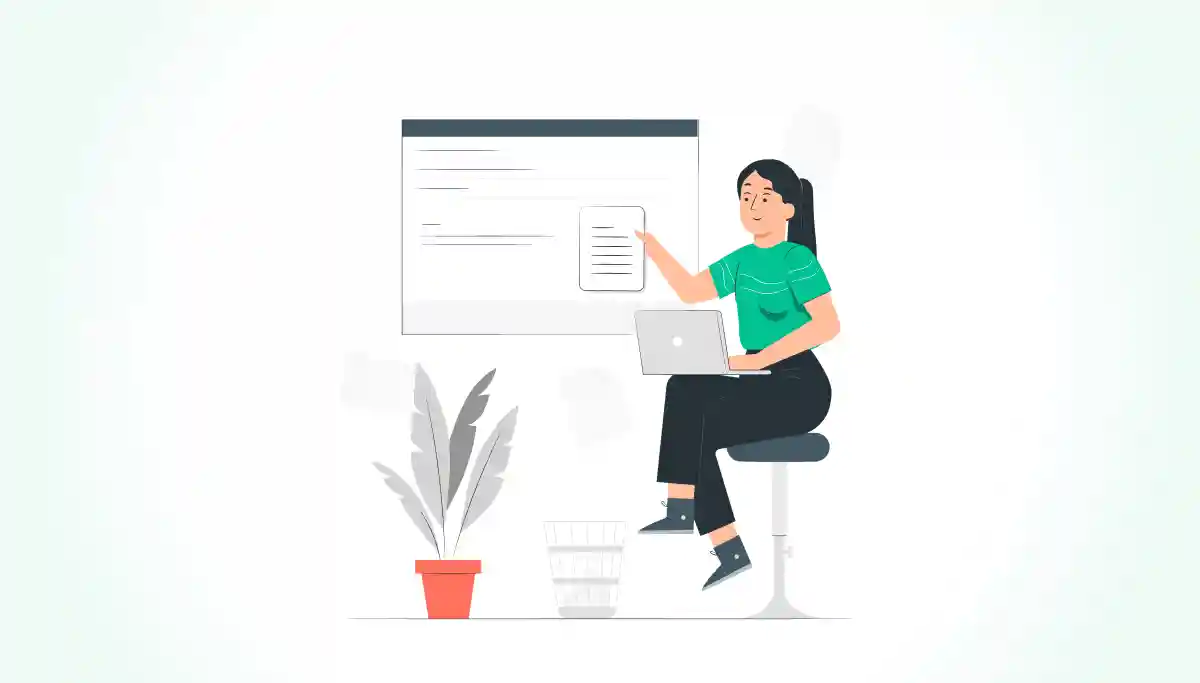Creating effective product tours is a game-changer when it comes to building customer onboarding processes that boost product adoption.
Without it, new users will struggle to understand your product, take meaningful actions, or reach their “aha” moment.
But what exactly are product tours? And how can you create one that customers will love without writing a single line of code?
Keep reading to learn how to build a good product tour that’s engaging, educational, and leaves a long-lasting positive impression on your customers.
What is a product tour?
A product tour is a UX onboarding pattern that contains a series of guided steps to showcase your product in action and get customers excited about it. They’re usually delivered in sequential order, with each step building on the one before it.
Product tours are a great way to demonstrate the benefits of your product and give customers a true sense of what the product is like. They can help you reduce drop-off rates, boost adoption, and increase conversion rates—so long as you do it right.
Benefits of product tour in SaaS
A well-designed product tour can help new users get acquainted with your product and understand how to use it. However, product tours also:
- get users to Aha moment faster: product tours guide users towards your Aha! moment by demonstrating the true value of your product and motivating them to continue their journey to activation
- show off new features of your product: Use product tours to illustrate the benefits of your new feature release so users have a reason to try it out.
- Product tours are engaging: Product tours have a natural flow that makes them fun and easy to follow. They’re informative and entertaining at the same time, which means people will be more likely to follow them through to the end.
- Product tours tell stories: Product tours are about storytelling — about the experience of using your product and how easy it is. Demonstrating that experience can inspire people to try out your product because they see just how valuable it is.
- Product tours are memorable: When someone watches a product tour video, it stays with them and acts as an in-app guide until they master your product
- Increase user engagement and retention: product tours can help increase user engagement and retention by providing a fun and interactive way for users to learn about your product.
- Customer education: interactive tours provide a shorter learning curve to educate users and also create a better, seamless onboarding process
When do product tours happen in SaaS?
Product tours are used for onboarding new users or introducing a new feature. This will give potential customers a chance to experience your product before they buy it, which is especially useful for customers who may need to justify their purchase.
Product tours vs. product onboarding… What’s the difference?
Product tours and product onboarding are two different, yet interwoven processes. Here’s the difference:
Product tours are a series of UX patterns that explain how a product works, what it does, and how it’s used. They’re usually created as part of an onboarding process
Product onboarding, on the other hand, comprises a series of steps that explain how to use a new product or service. Unlike product tours, which are a one-time thing, onboarding goes beyond the initial interaction with users.
How to build an effective product tour for your SaaS
What differentiates successful product tours from mediocre ones? Let’s have a look at the best practices for building an effective product tour that customers will love.
1. Understand the customer and the job-to-be-done: The first rule to getting your product tour right is to know what individual customers seek to accomplish with your product. This means that even before you build a product tour, you must have a user persona that gives an ideal representation of your customer.
This can then be translated into an onboarding survey to help you get better data about your customers. Here’s an example of an onboarding survey in Canva.

2. Segment users to personalize their experience: Customer Segmentation means grouping customers into various categories based on their similar characteristics. This way, you can customize onboarding, messaging, and even in-app trigger time to appear at the right time without causing a nuisance.
3. Match the right UI elements to the right user action: Good product tours are all about showing the right UI element contextually. Take for example, when announcing a new feature, a modal would grab the attention of the user faster than a tooltip. Likewise, when showing a new user how to use a new feature, a tooltip or hotspot would work better.
4. Clarity is key: Vague, ambiguous, or complicated product tours can lead to one thing: a high rate of churned customers. The whole point of a product tour is to show users around and excite them about your product and a confusing tour defeats that goal.
5. Use visuals correctly: What users see often translates to how they feel about your product. Make your product tour more fun by using images or videos— but make sure they’re relevant!
6. Keep it short: Nobody likes a long, vertical product tour. Truth is, users would rather skip through than sit through a long tour. Instead of making your product tours a long stretch, make them interactive. Interactive tours are short, interesting, and easier to follow.
7. Be sequential: Customer onboarding must follow a logical sequence such that it takes anyone–even a complete beginner–on a journey on how to use your product. So, it must start from the simple steps and gradually progress into the more advanced features it takes to reach their goal.
8. Highlight product benefits: Start by talking about what makes your product unique from other products in your category. This will give you an opportunity to highlight the key features and benefits of using your app. Don’t go into too much detail — it’s more important that people understand what you’re offering than how it works.
Schedule a demo with one of our experts to take a deeper dive into Churn360
Book a demo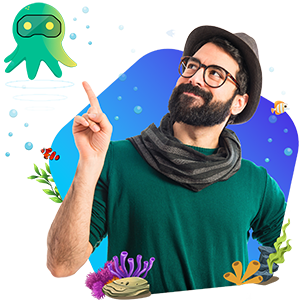
How to improve an existing product tour in SaaS
1. Look at user analytics to see where users are dropping off, getting stuck, and the completion rate. This could reveal a number of things about how users truly feel about the product tours.
2. Create a plan on how to improve your product tour. Next, implement these changes accordingly.
3. Run A/B testing to test your new product tour. Test elements like UI patterns, microcopy, visuals, and even order of arrangement.
UI patterns for building effective SaaS product tour
To create effective saas product tours, check our complete guide on customer onboarding. While you do so, here are some UI patterns to take note of when building your product tour.
Modals
You would easily recognize a modal from its manner of display. They are large, rectangular, and, in most cases, cover the user’s screen in order to grab attention. In SaaS, they can also be useful to illustrate key features and benefits or offer additional details about the product itself.
Modals are especially useful for product tours where you want to get users engaged but don’t want to overwhelm them with a bunch of information at once. They can also be used to drive user engagement by prompting them to complete an action, such as submitting their contact information or signing up for email updates.
Here’s an example of Kontentino’s welcome screen modal:
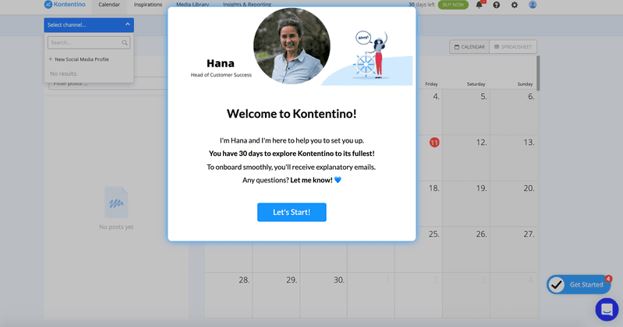
Tooltips
The best way to build a more effective product tour is by using tooltips. Tooltips are small bits of text that appear when you hover over points of interest on your product tour.
Tooltips are one of the most important parts of your product tour; these can be a simple message or a detailed walkthrough of every feature. Either way, they explain all the features, benefits, and other things that your prospective customers need to know about your product.
Here’s an example from Airtable:

Hotspots
Like tooltips, hotspots are subtle UI patterns that drive the user’s attention; however, hotspots are less aggressive. The idea behind hotspots is to draw users to a certain feature and provide on-demand guidance and tips to enhance their experience.
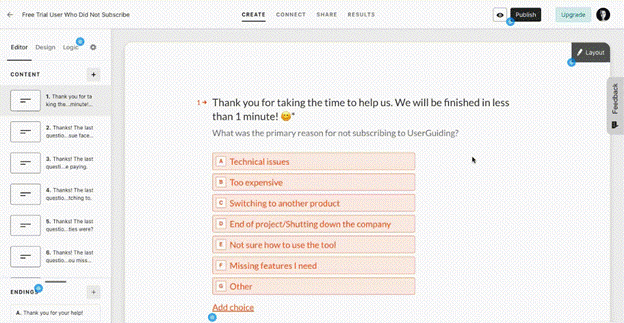
Checklists
No matter how simple your product tours are, it’s hard to get SaaS users to the activation point. This is because SaaS users sometimes leave tasks incomplete when it feels like there’s no progress, but a checklist changes all of that.
Checklists display onboarding tasks in an orderly manner that is simple enough for users to understand. It leverages a psychological effect called the Zeigarnik effect, which focuses on the tendency for human minds to complete tasks.
Evernote uses this phenomenon by showing their users how easy it is to complete each task–in this case, writing their first note.
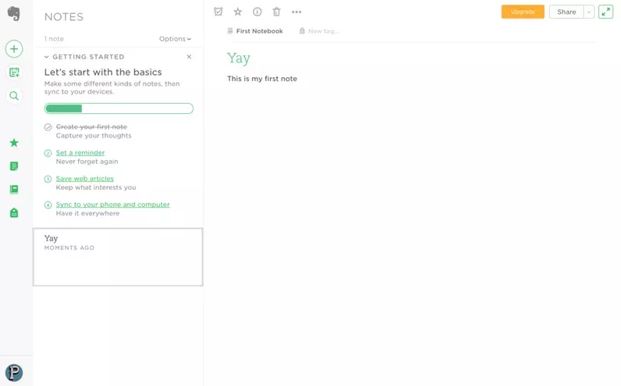
4 Product Tour examples for Inspiration
Now that you’ve learned the basics of creating a product tour that boosts adoption, let’s take a sneak peek into how other SaaS companies are currently using product tours.
Canva: new feature product tour
Check out this Canva Product Tour Video
This is an example of a product tour used by design software, Canva, to help users discover the benefits of their new feature–creating a video on Canva. The goal of this product tour is to demonstrate the simplicity of using Canva while also driving users to take immediate action.

What we love about this product tour:
- Canva’s product tour reflects the company’s unique proposition of simplicity and ease. Each element is designed without a UI cluster and demonstrates the results of the product in its design.
- Canva takes the show, not tell approach in marketing. This is when users are allowed to experience the product themselves and play around with it, instead of being shown.
- The flawless combination of UI elements and visuals inspires the users to take action.
Grammarly: onboarding product tour
Grammarly’s product tour is simple and straightforward. It starts with an announcement modal that lets new users choose if they want to start or skip the tour. Rather than displaying random UI elements to users, they draw them into a demo environment to demonstrate the product.

In this demo environment, new users can play around with editing a sample article. This way, they can see how Grammarly edits articles in real-time.
Want to create a similar product tour for your product? Book a demo call with the Churn360 team and see how you can get started today!
Slack: onboarding product tour
To reduce the number of users dropping off, Slack coaches users to learn about their product in a fun, interactive way. They make use of bright and colorful UI elements to explain feature functionalities, benefits, and product terminologies.
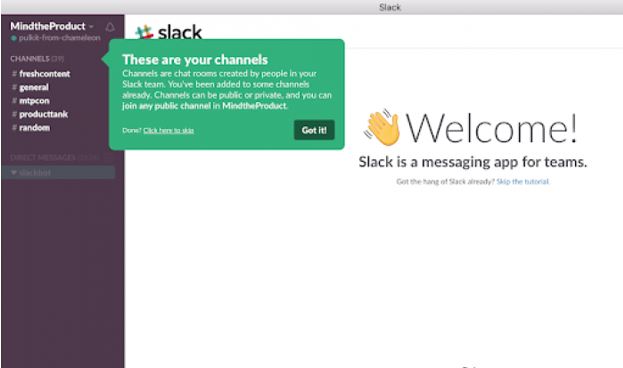
Best Interactive Product Tour Software and Tools
Adding product tours into your onboarding process can help SaaS users learn more about your product. But there are tons of great tools and software out there to help you create interactive product tours.
Here are some to consider:
Churn360
Churn360 is an interactive product tour software and tool that helps create engaging and interactive product tours in minutes. It aims to help you convert users by providing a shorter learning curve to educate users.

Appcues
Appcues is a product tour software and service provider that helps you create engaging, interactive, and visual tours for your product. Appcues offers a variety of product tour templates, such as video tours, 3D walkthroughs, product demos, and more. You can choose from a selection of different elements to customize your tour or build it from scratch.

Userpilot
Userpilot is a full-featured, easy to use tool that helps you create interactive product tours. With this tool, you can create a beautiful, engaging user experience by allowing customers to virtually walk through your product. Customers can test out different functionalities and features on the fly and provide valuable feedback to help make improvements to your product.
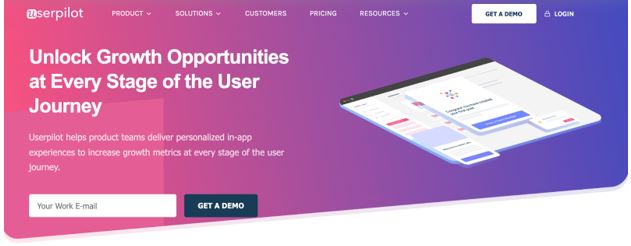
Conclusion
Embedding interactive product tours into your onboarding process is a great way to make sure potential users can learn how to use your product.
But when you choose software to create your product tour, make sure you’re choosing one that’s not stressful, easy to maintain, and less expensive—just like Churn360.
Ready to get started? Request a Churn360 demo today and start your journey toward building a clientele of happy customers.
